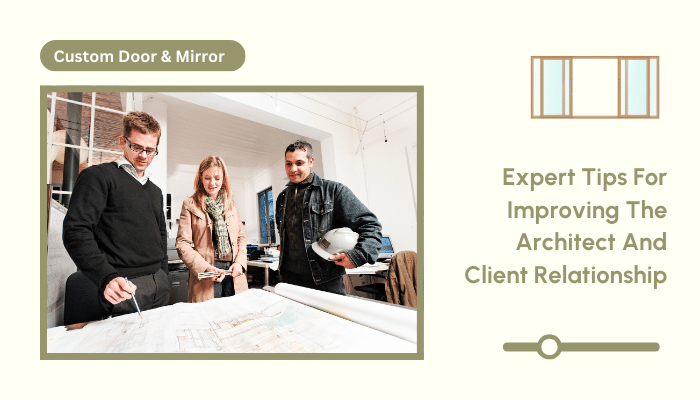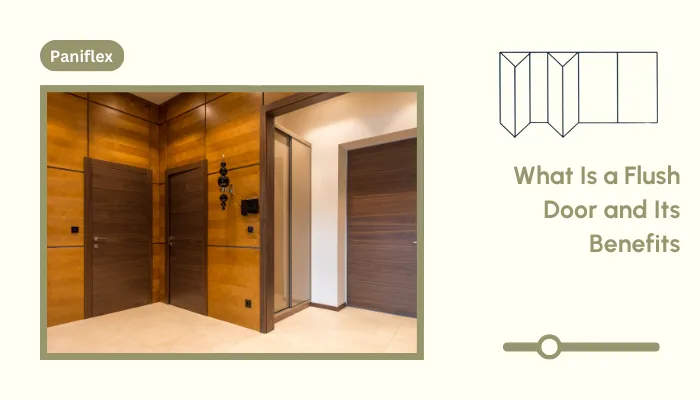Every architectural project begins with more than just blueprints—it starts with trust. Whether designing a luxurious residential space or a cutting-edge commercial facility, the bond between an architect and their client transforms creative concepts into tangible realities. A collaborative relationship ensures that the client’s vision is fully realized while maintaining the integrity of the architect’s expertise.
But how can architects, interior designers, and contractors consistently achieve this harmony? Building a productive, trust-based relationship requires more than technical skill. It involves clear communication, managing expectations, and fostering collaboration. Let’s explore actionable strategies for creating successful client partnerships.
Ready to experience the benefits of custom closet doors? Explore our range of Paniflex products now.
Why is strong communication the foundation of success?
Miscommunication can derail even the most well-designed projects. Clients often lack the technical expertise to fully understand architectural jargon or blueprints, leading to confusion and misalignment.
When discussing concepts, simplify your language. Rather than using highly technical terms, explain how features align with the client’s vision. The key is to keep the client in the loop throughout the process with regular updates and touchpoints. Consider developing a structured communication plan at the start of the project. This plan will provide clarity on when and how updates will be shared, minimizing uncertainty.
How can financial transparency prevent friction?
Budget conversations can be tricky, but they’re crucial for a successful partnership. Clients appreciate architects who are upfront about costs, timelines, and potential trade-offs, as this ensures they’re fully aware of what to expect.
Aligning financial expectations from the outset helps avoid surprises down the road. Provide detailed estimates that clearly outline materials, labor, and other costs. This not only builds trust but also positions you as a professional who values integrity.
For contractors and interior designers, transparent pricing on customizable elements, like high-quality doors or fixtures, can further emphasize your commitment to value-driven design. By focusing on clear communication around costs, you reinforce the client’s confidence in the process.
What role does adaptability play in the client relationship?
Every client is different, and so is every project. Adapting your workflow to align with their preferences can significantly enhance the client experience. For example, some clients may prefer frequent in-person meetings, while others might prefer virtual updates or concise email summaries.
Tailor your approach based on what resonates most with the client. This adaptability demonstrates that you value their input and are willing to accommodate their needs. It’s not about changing your process entirely but about making adjustments that show a willingness to collaborate.
How can technology enhance collaboration?
The architectural field is evolving rapidly, with technology playing a pivotal role in improving collaboration and efficiency. Clients increasingly expect more interactive ways to engage with their projects.
Investing in tools like Artificial intelligence, 3D modeling, rendering software, and augmented reality helps bridge the gap between your vision and the client’s understanding. These technologies allow clients to see detailed representations of the design, reducing the likelihood of revisions later in the project. Staying updated with the latest advancements showcases your expertise and commitment to excellence.
Why is understanding your client’s context essential?
Each client has unique goals driven by their business or personal priorities. Whether designing for a corporate office or a residential space, understanding their needs on both a macro and micro level allows you to deliver designs that align with their vision.
For example, a corporate client may value cost-efficiency and functionality, while a homeowner may prioritize aesthetics and personalization. By aligning your designs with these objectives, you show a deeper commitment to their success, strengthening your relationship.
Can a strong online presence improve client relationships?
In today’s digital-first world, your online presence often serves as the first impression for potential clients. A well-maintained website, active social media accounts, and an up-to-date portfolio showcase your expertise and credibility.
Sharing case studies, behind-the-scenes insights, or client testimonials not only highlights your past successes but also inspires confidence in prospective clients. Ensuring that your contact information and content are accessible makes it easier for clients to engage with you.
Why is ongoing education vital in architecture?
Staying informed about the latest trends, materials, and technologies is key to offering the best solutions to your clients. The more knowledgeable you are, the better you can guide clients in making informed decisions.
For instance, understanding advancements in materials or techniques allows you to propose innovative solutions that align with the client’s needs. This proactive approach further positions you as a trusted expert in the field.
How do post-project connections benefit your business?
The end of a project doesn’t mean the end of a relationship. Staying connected with past clients opens doors for repeat business and referrals. A quick check-in email, an invite to see a new project, or sharing updates about industry trends can help keep the connection alive.
These touchpoints show that you value the relationship beyond the scope of the project, reinforcing their trust and encouraging them to recommend you to others.
How does proactive problem-solving set you apart?
Anticipating potential challenges and addressing them early not only saves time but also strengthens your credibility. Clients appreciate architects who come prepared with solutions rather than merely identifying problems. For instance, before presenting a design, consider potential construction constraints or budget limitations that might arise and have actionable alternatives ready.
Proactive problem-solving also involves understanding market dynamics. Familiarize yourself with local regulations, zoning laws, and material availability. This insight can help you avoid delays, keep the project on track, and maintain the client’s confidence in your abilities.
What makes collaboration with contractors vital?
Architects and contractors are two sides of the same coin. While architects bring creative visions to life, contractors ensure those visions are realized within practical constraints. Strengthening your collaboration with contractors enhances the overall client experience and ensures smoother execution.
Maintain open communication with contractors throughout the project. Share detailed plans, solicit feedback on feasibility, and address their concerns early. This collaborative approach minimizes miscommunication and aligns everyone toward the shared goal of delivering exceptional results for the client.
Pro tip: Introducing tools like shared project management software can improve coordination between architects, contractors, and clients, ensuring everyone remains updated on progress.
Why is investing in long-term relationships beneficial?
For many architects, each project is treated as a standalone endeavor. However, nurturing long-term relationships with clients can open doors to future collaborations and referrals. Consider the bigger picture: A satisfied client not only returns but also becomes an advocate for your brand.
After project completion, stay in touch by sharing updates on industry trends, your new projects, or relevant innovations. For example, if a new design material or technology aligns with their interests, let them know. This ongoing engagement reinforces trust and keeps your name top of mind for future opportunities.
How can you tailor your approach to different client types?
No two clients are alike, and a one-size-fits-all approach rarely works. Understanding the nuances of each client’s preferences, industry, and goals allows you to provide a more customized experience.
For instance:
- Corporate clients: Focus on functionality, cost-efficiency, and scalability. Demonstrate how your design can support their business operations and adapt to future needs.
- Residential clients: Prioritize personalization and aesthetics. Showcase examples of how your designs reflect individuality and enhance daily living.
- Contractors and developers: Highlight practical aspects like ease of construction, time-saving solutions, and clear documentation.
This tailored approach demonstrates your commitment to understanding their specific needs, making them more likely to trust and collaborate with you.
How does environmental consciousness impact client trust?
Sustainability is no longer just a trend; it’s an expectation. Clients increasingly seek architects who can incorporate eco-friendly practices and materials into their projects. By showcasing your knowledge of sustainable design, you position yourself as a forward-thinking professional who cares about the bigger picture.
Incorporate renewable materials, energy-efficient systems, and green building certifications into your designs. Communicate the long-term benefits of these choices to clients, such as reduced energy costs and enhanced property value. This not only sets you apart but also aligns your projects with modern values.
How can leveraging feedback drive continuous improvement?
Feedback is a cornerstone of growth in the client-architect relationship. Whether it’s constructive criticism or positive reinforcement, it provides insights that help refine your process and strengthen future collaborations.
Encourage regular feedback sessions: Create touchpoints at various stages of the project to ask clients about their satisfaction and address any concerns. This proactive approach helps catch potential issues early and builds trust by showing that you value their input.
Document and analyze feedback: Maintain a record of client feedback and reflect on common patterns. For instance, if multiple clients mention communication delays, it’s a cue to streamline your process. Implementing improvements based on this analysis demonstrates your commitment to delivering an exceptional client experience.
Ready to experience the benefits of custom closet doors? Explore our range of Paniflex products now.
Why is emotional intelligence critical in client relationships?
The client-architect relationship is as much about emotions as it is about logistics. Understanding your client’s emotional needs and responding with empathy can make all the difference in building a lasting connection.
Listen actively: When clients share their vision, frustrations, or concerns, pay close attention to both their words and their tone. Reflecting their emotions back with empathy—such as acknowledging their excitement or addressing their anxiety—helps them feel understood.
Manage stress tactfully: High-stakes projects can be stressful for everyone involved. By staying calm and solution-oriented in challenging moments, you reassure your clients and maintain their confidence in your expertise.
Adapt to personality types: Some clients may be highly detail-oriented and want to be involved in every decision, while others might prefer a more hands-off approach. Tailoring your communication style to suit their preferences shows emotional intelligence and flexibility.
How can storytelling elevate your presentations?
Numbers and technical details are essential, but they rarely inspire. Storytelling allows you to convey the “why” behind your designs in a way that resonates emotionally with clients.
Craft a narrative around the client’s vision: For instance, if you’re designing a family home, describe how the layout fosters togetherness in shared spaces while offering personal retreats for privacy. This turns abstract designs into relatable experiences.
Highlight past successes through stories: Share case studies that demonstrate your ability to solve problems or exceed expectations. Frame these examples as stories of transformation, showing how you helped clients achieve their goals.
Connect design choices to emotions: Explain how elements like natural lighting, open layouts, or specific materials can influence mood and functionality. Tying your decisions to emotional benefits helps clients see the value of your expertise.
Why is defining boundaries important in client relationships?
While client satisfaction is a top priority, setting boundaries ensures that projects remain manageable and relationships stay professional. Without clear boundaries, you risk overextending yourself and compromising the quality of your work.
Establish clear expectations early: During the onboarding process, outline the scope of the project, timelines, and communication protocols. This helps avoid misunderstandings later.
Balance accessibility with productivity: While clients value responsiveness, being available 24/7 can lead to burnout. Set realistic availability hours and communicate these to your clients. You can use tools like email auto-replies to manage expectations when you’re unavailable.
Say no when necessary: If a client requests changes that compromise the integrity of the design or exceed the agreed scope, explain your reasoning with professionalism. Offering alternative solutions shows that you’re willing to collaborate without overcommitting.
How can networking within the industry strengthen client trust?
Strong relationships with industry peers—contractors, suppliers, and designers—enhance your ability to deliver seamless projects and foster client confidence.
Leverage professional networks: Collaborating with trusted contractors or sourcing materials from reliable suppliers ensures consistent quality. Clients appreciate architects who can recommend skilled professionals and streamline processes.
Stay informed through community engagement: Attend industry events, workshops, and trade shows to stay updated on the latest trends and technologies. This not only sharpens your expertise but also signals to clients that you’re invested in continuous improvement.
Collaborate with complementary professionals: Building alliances with interior designers or engineers can provide a comprehensive approach to projects. When clients see a cohesive team working toward their goals, it builds trust in your capabilities.
Conclusion: the blueprint for successful relationships
The client-architect relationship is about more than just delivering a project—it’s about creating a collaborative partnership that lasts. By focusing on communication, adaptability, and understanding, you can build relationships that not only result in successful projects but also lead to long-term opportunities.
At the heart of these partnerships is a commitment to quality, transparency, and innovation. Whether it’s through using advanced tools, staying informed about industry trends, or tailoring designs to client needs, the effort you invest in strengthening these relationships will shape your success.
Transform Your Spaces with Paniflex Custom Doors and Closets
Looking to bring your designs to life with premium, tailored solutions? Paniflex offers high-quality custom doors and closets that seamlessly blend style and functionality. Whether you’re an architect, interior designer, or homeowner, our expert craftsmanship and versatile designs elevate any project.
Visit Paniflex Custom Doors and Closets to explore our extensive collection and start creating inspiring spaces. Let’s build something extraordinary together!






